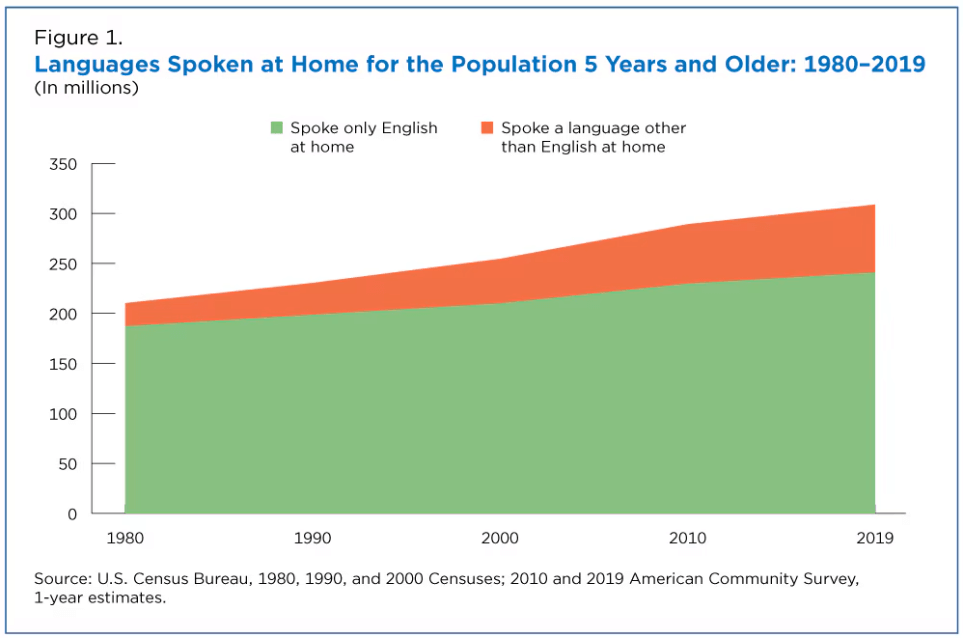Neurolinguistics, Migration, and Language Diversity: A Primer for National Hispanic Heritage Month

[Editor’s Note: A double-whammy: September is National Translation Month, and National Hispanic Heritage Month began this week! In this blog post, we recognize the rich diversity that Spanish-speaking communities contribute to the United States by taking a closer look at language.]
When fleeing conflict, escaping environmental crises, or seeking better economic opportunities, migrants bring their languages with them—a vital aspect of their identity that shapes how they see themselves and how others perceive them. But migrants don’t just bring their own language: moving to a new country like the United States often involves the challenging process of learning a new language and adapting to a different culture. This is particularly true for migrants and immigrants from Spanish-speaking countries, whose language also evolves and adapts along the way. Recognizing the resilience and transformation involved in immigrants’ language adaptation helps us see the immigrant journey as one of growth and enrichment.
Our brain’s ability to adapt and change in response to new experiences, known as neuroplasticity, is fundamental to learning, including language acquisition. Neuroplasticity plays a crucial role for immigrants, especially those learning a new language later in life. While younger individuals often learn new languages more easily, adults can still master a second or even third language, thanks to the brain’s remarkable capacity to reorganize itself.
In bilingual or multilingual individuals, the brain exhibits unique patterns of activity. Research shows that managing multiple languages can enhance cognitive functions such as executive control, problem-solving, task switching, and maintaining focus. This is because bilingual individuals constantly practice these skills as they navigate between languages. Additionally, the bilingual brain is often better at multitasking and may experience a delayed onset of cognitive decline compared to monolinguals. For us, these cognitive advantages can be a significant asset in adapting to new environments, where processing and responding to complex information quickly is essential.
Learning a new language is demanding, and for us as immigrants, this process often occurs under stressful conditions, impacting cognitive functions. Cognitive load refers to the mental effort required to process and retain new information, which is exceptionally high when learning a new language. This load is compounded by immigration stressors, such as navigating a new culture, securing employment, and maintaining family connections.
Stress can significantly affect our language processing. High-stress levels can impair memory retention, making it harder to remember new vocabulary or grammatical rules. It can also affect language production, leading to difficulty speaking fluently or accurately under pressure. For example, we might struggle to communicate effectively in a job interview or during a meaningful conversation due to the combined effects of cognitive load and stress.
Yet, our brain’s neuroplasticity offers a path to overcoming these challenges. By gradually reducing cognitive load through consistent practice and managing stress, we can improve our language skills. Supportive social networks, access to language learning resources, and opportunities to practice the new language in low-stress environments are crucial in helping us navigate these demands.
Beyond the remarkable world of neuroplasticity, there are many more factors of language acquisition in migrants and immigrants that are worth noting. For example, not all Spanish is the same, and immigrants and migrants from Spanish-speaking countries learn to integrate their native Spanish with the versions of Spanish spoken here in the United States, which carry linguistic nuances shaped by various ethnic backgrounds and geographic locations. It is important to recognize that no one’s country’s Spanish is inherently better or more correct than another’s; each reflects the cultural and historical contexts from which they emerged. Over time, as Spanish-speaking communities have become less isolated and more interconnected with other Spanish speakers from different origins, these dialects have influenced one another, contributing to the vibrance of American Spanish, now the most commonly spoken non-English language in the United States.
Immigrants and migrants also frequently code switch, where individuals alternate between languages and dialects to navigate different social settings and cultural expectations. Language is more than just a means of communication; it is a crucial element of identity formation and cultural expression, deeply influenced by social contexts and power dynamics.
At Migrant Clinicians Network, we understand that language is constantly evolving as society and cultural values change. We strive to use language that celebrates the diversity of the communities we serve, remains respectful and inclusive, and mitigates the harmful impacts of bias. As part of our commitment to Diversity, Equity, Inclusion, and Accessibility (DEIA), we routinely review our content and welcome feedback on our language use, updating it as needed. Celebrating and supporting this diversity is essential for creating a more inclusive and understanding society.
- Log in to post comments







